jQuery Data Manipulate API - A source code dissecting journey
- 1. jQuery Data Manipulate A source code dissecting journey Huiyi Yan
- 2. HTML5 data-* Attributes <li class="user" data-name="John Resig" data-city="Boston" data-lang="js" data-food="Bacon"> <b>John says:</b> <span>Hello, how are you?</span> </li> var user = document.getElementsByTagName("li")[0]; var pos = 0, span = user.getElementsByTagName("span")[0]; var phrases = [ {name: "city", prefix: "I am from "}, {name: "food", prefix: "I like to eat "}, {name: "lang", prefix: "I like to program in "} ]; user.addEventListener( "click", function(){ var phrase = phrases[ pos++ ]; // Use the .dataset property span.innerHTML = phrase.prefix + user.dataset[ phrase.name ]; }, false); REF> http://ejohn.org/blog/html-5-data-attributes/
- 3. HTML5 data-* Attributes span.innerHTML = phrase.prefix + user.getAttribute("data-" + phrase.name ) The .dataset property behaves very similarly to the the .attributes property (but it only works as a map of key-value pairs)
- 4. HTML5 data-* Attributes While I firmly believe that useful data should be made visible to users, there are circumstances where data-* attributes make sense. For instance, including data-lat and data-lng attributes in an element containing a street address would allow for easily adding markers to a Google Map on the page: <span data-lat="38.8951" data-lng="-77.0363"> 1600 Pennsylvania Ave. Washington, DC </span> “ ” REF> http://www.viget.com/inspire/extending-paul-irishs-comprehensive-dom-ready-execution/
- 5. HTML5 data-* Attributes Taking a step back, we can use data-* attributes on the body element to provide an indication of where we are within an application: <body data-controller="<%= controller_name %>" data- action="<%= action_name %>"> <body data-controller="users" data-action="show"> The above code will yield something like: REF> http://www.viget.com/inspire/extending-paul-irishs-comprehensive-dom-ready-execution/
- 6. .data()/jQuery.data() .data( key, value ) .data( key, value ) .data( obj ) .data( key ) .data( key ) .data()
- 7. .data()/jQuery.data() <div> The values stored were <span></span> and <span></span> </div> $("div").data("test", { first: 16, last: "pizza!" }); $("span:first").text($("div").data("test").first); $("span:last").text($("div").data("test").last); <div data-role="page" data-last-value="43" data- hidden="true" data-options='{"name":"John"}'></div> $("div").data("role") === "page"; $("div").data("lastValue") === 43; $("div").data("hidden") === true; $("div").data("options").name === "John";
- 8. .data()/jQuery.data() var myObj = {}; $(myObj).data("city", "Springfield"); myObj.city = "Springfield" var progressBar = {}; $(progressBar).bind('setData', function(e, key, value) { switch (key) { case "percent": $("#progress").width(value + "%"); $("#percentText").text(value + "%"); break; case "color": $("#progress").css("color", value); break; case "enabled": $('#progress').toggleClass("active", value); break; } }); $(progressBar).data("enabled", true).data("percent", 21).data("color","green"); // You also have easy access to the current values: console.log(progressBar.enabled); // true
- 9. .data()/jQuery.data() getData – triggered before data is read from the object. changeData – triggered whenever data is set or changed. It is used in the jQuery datalink plugin .
- 10. . removeData()/ jQuery.removeData() .removeData( [ name ] ) <div>value1 before creation: <span></span></div> <div>value1 after creation: <span></span></div> <div>value1 after removal: <span></span></div> $("span:eq(0)").text("" + $("div").data("test1")); $("div").data("test1", "VALUE-1"); $("div").data("test2", "VALUE-2"); $("span:eq(1)").text("" + $("div").data("test1")); $("div").removeData("test1"); $("span:eq(2)").text("" + $("div").data("test1")); $("span:eq(3)").text("" + $("div").data("test2"));
- 11. jQuery.hasData() jQuery.hasData( element ) The primary advantage of jQuery.hasData(element) is that it does not create and associate a data object with the element if none currently exists. In contrast, jQuery.data(element) always returns a data object to the caller, creating one if no data object previously existed. “ ”
- 12. jQuery.hasData() $(function(){ var $p = jQuery("p"), p = $p[0]; $p.append(jQuery.hasData(p)+" "); /* false */ jQuery.data(p, "testing", 123); $p.append(jQuery.hasData(p)+" "); /* true*/ jQuery.removeData(p, "testing"); $p.append(jQuery.hasData(p)+" "); /* false */ });
- 14. Utilities // Populate the class2type map jQuery.each("Boolean Number String Function Array Date RegExp Object".split(" "), function(i, name) { class2type["[object " + name + "]"] =name.toLowerCase(); }); type: function(obj) { return obj == null ? String(obj) :class2type[toString.cal l(obj)] || "object"; }, // See test/unit/core.js for details concerning isFunction. // Since version 1.3, DOM methods and functions like alert // aren't supported. They return false on IE (#2968). isFunction: function(obj) { return jQuery.type(obj) === "function"; }, jQuery.isFunction()
- 15. Utilities // Use native String.trim function wherever possible trim: trim ? function(text) { return text == null ? "" : trim.call(text); } : // Otherwise use our own trimming functionality function(text) { return text == null ? "" :text.toString().replace(trimLef t,"") .replace(trimRight, ""); }, jQuery.trim()
- 16. Utilities isEmptyObject: function(obj) { for (var name in obj) { return false; } return true; }, jQuery.isEmptyObject()
- 17. Utilities isPlainObject: function(obj) { // Must be an Object. // Because of IE, we also have to check the presence of the constructor property. // Make sure that DOM nodes and window objects don't pass through, as well if (!obj || jQuery.type(obj) !== "object" ||obj.nodeType || jQuery.isWindow(obj )) { return false; } // Not own constructor property must be Object if (obj.constructor && !hasOwn.call(obj,"constructor") &&!hasOwn.call(obj.constructor.prototype,"isPrototypeOf")) { return false; } // Own properties are enumerated firstly, so to speed up, // if last one is own, then all properties are own. var key; for (key in obj) {} return key === undefined || hasOwn.call(obj,key); }, jQuery.isPlainObject()
- 18. Utilities globalEval: function(data) { if (data && rnotwhite.test(data)) { // We use execScript on Internet Explorer // We use an anonymous function so that context is window // rather than jQuery in Firefox (window.execScript || function(data) { window["eval"].call(window, data); })(data); } }, jQuery.globalEval()
- 19. Utilities // Bind a function to a context, optionally partially applying any // arguments. proxy: function(fn, context) { if (typeof context === "string") { var tmp = fn[context]; context = fn; fn = tmp; } // Quick check to determine if target is callable, in the spec // this throws a TypeError, but we will just return undefined. if (!jQuery.isFunction(fn)) { return undefined; } // Simulated bind var args = slice.call(arguments, 2), proxy = function() { return fn.apply(context,args.concat(slice.call(arguments))); }; // Set the guid of unique handler to the same of original handler, so it can be removed proxy.guid = fn.guid = fn.guid || proxy.guid ||jQuery.guid++; return proxy; }, jQuery.proxy()
- 20. UtilitiesjQuery.each() // args is for internal usage only each: function(object, callback, args) { var name, i = 0, length = object.length, isObj = length === undefined || jQuery.isFunction(object); if (args) { if (isObj) { for (name in object) { if (callback.apply(object[name], args) === false) { break; } } } else { for (; i < length;) { if (callback.apply(object[i++], args) === false) { break; } } }
- 21. UtilitiesjQuery.each() // A special, fast, case for the most common use of each } else { if (isObj) { for (name in object) { if (callback.call(object[name], name, object[name]) ===false) { break; } } } else { for (; i < length;) { if (callback.call(object[i], i, object[i++]) === fa lse) { break; } } } } return object; },
- 23. Miscellaneous .index() .index( selector ) selector A selector representing a jQuery collection in which to look for an element. .index( element ) element The DOM element or first element within the jQuery object to look for.
- 24. Miscellaneous <span>Click a div!</span> <div>First div</div> <div>Second div</div> <div>Third div</div> <script> $("div").click(function () { // this is the dom element clicked var index = $("div").index(this); $("span").text("That was div index #" + index); }); </script> .index() On click, returns the index (based zero) of that div in the page.
- 25. Miscellaneous <ul> <li id="foo">foo</li> <li id="bar">bar</li> <li id="baz">baz</li> </ul> <div></div> <script>$('div').html('Index: ' + $('#bar').index('li') );</script> .index() Returns the index for the element with ID bar in relation to all <li> elements.
- 26. Miscellaneous toArray: function() { return slice.call(this, 0); } Reversed - <span></span> <div>One</div> <div>Two</div> <div>Three</div> <script> function disp(divs) { var a = []; for (var i = 0; i < divs.length; i++) { a.push(divs[i].innerHTML); } $("span").text(a.join(" ")); } disp($("div").toArray().reverse()); </script> toArray()
- 27. Miscellaneous .map( ).map( callback(index, domElement) ) callback(index, domElement)A function object that will be invoked for each element in the current set.
- 28. Miscellaneous <input type="button" value="equalize div heights"> <div style="background:red; height: 40px; "></div> <div style="background:green; height: 70px;"></div> <div style="background:blue; height: 50px; "></div> <script> $.fn.equalizeHeights = function(){ return this.height( Math.max.apply(this, $(this).map(function(i,e){ return $(e).height() }).get() ) ) } $('input').click(function(){ $('div').equalizeHeights(); }); </script> .map( )Equalize the heights of the divs.
- 29. Miscellaneous map: function(callback) { return this.pushStack(jQuery.map(this, function( elem, i) { return callback.call(elem, i, elem); })); }, .map( )
- 30. Miscellaneous// arg is for internal usage only map: function(elems, callback, arg) { var value, key, ret = [], i = 0, length = elems.length, // jquery objects are treated as arrays isArray = elems instanceof jQuery || length !== undefined &&typeof length === "number" & & ((length > 0 && elems[0] && elems[length -1]) || length === 0 || jQuery.isArray(elems)); // Go through the array, translating each of the items to their if (isArray) { for (; i < length; i++) { value = callback(elems[i], i, arg); if (value != null) { ret[ret.length] = value; } } // Go through every key on the object, } else { for (key in elems) { value = callback(elems[key], key, arg); if (value != null) { ret[ret.length] = value; } } } // Flatten any nested arrays return ret.concat.apply([], ret); }, .map( )
- 31. Miscellaneous // Take an array of elements and push it onto the stack // (returning the new matched element set) pushStack: function(elems, name, selector) { // Build a new jQuery matched element set var ret = this.constructor(); if (jQuery.isArray(elems)) { push.apply(ret, elems); } else { jQuery.merge(ret, elems); } // Add the old object onto the stack (as a reference) ret.prevObject = this; ret.context = this.context; if (name === "find") { ret.selector = this.selector + (this.selector ? " " : "") +selector; } else if (name) { ret.selector = this.selector + "." + name + "(" + selector +")"; } // Return the newly-formed element set return ret; }, .map( )
- 32. Miscellaneous // Determine the position of an element within // the matched set of elements index: function(elem) { if (!elem || typeof elem === "string") { return jQuery.inArray(this[0], // If it receives a string, the selector is used // If it receives nothing, the siblings are used elem ? jQuery(elem) : this.parent().children()); } // Locate the position of the desired element return jQuery.inArray( // If it receives a jQuery object, the first element is used elem.jquery ? elem[0] : elem, this); }, .index()
- 33. Miscellaneous // Get the Nth element in the matched element set OR // Get the whole matched element set as a clean array get: function(num) { return num == null ? // Return a 'clean' array this.toArray() : // Return just the object (num < 0 ? this[this.length + num] : this[num]); }, .get()
- 35. General Attributes attr: function(name, value) { return jQuery.access(this, name, value, true, jQuery.a ttr); }, removeAttr: function(name) { return this.each(function() { jQuery.removeAttr(this, name); }); }, .attr() .removeAttr()
- 36. General Attributes prop: function(name, value) { return jQuery.access(this, name, value, true, jQuery. prop); }, removeProp: function(name) { return this.each(function() { // try/catch handles cases where IE balks (such as removing a property on window) try { this[name] = undefined; delete this[name]; } catch (e) {} }); }, .prop() .removeProp()


![HTML5 data-* Attributes
<li class="user" data-name="John Resig" data-city="Boston"
data-lang="js" data-food="Bacon">
<b>John says:</b> <span>Hello, how are you?</span>
</li>
var user = document.getElementsByTagName("li")[0];
var pos = 0, span = user.getElementsByTagName("span")[0];
var phrases = [
{name: "city", prefix: "I am from "},
{name: "food", prefix: "I like to eat "},
{name: "lang", prefix: "I like to program in "}
];
user.addEventListener( "click", function(){
var phrase = phrases[ pos++ ];
// Use the .dataset property
span.innerHTML = phrase.prefix + user.dataset[ phrase.name ];
}, false);
REF> http://ejohn.org/blog/html-5-data-attributes/](https://image.slidesharecdn.com/jquery-data-manipulate-v7-200109230852/85/jQuery-Data-Manipulate-API-A-source-code-dissecting-journey-2-320.jpg)

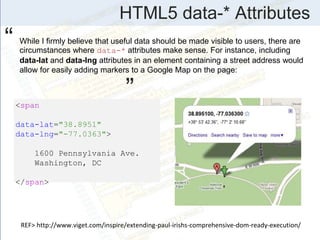
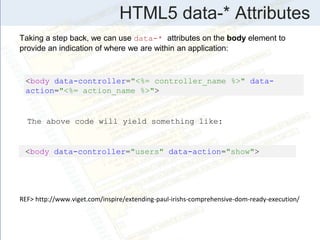
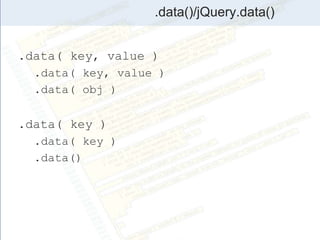

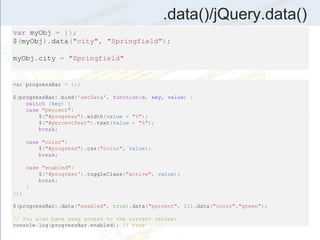

![. removeData()/ jQuery.removeData()
.removeData( [ name ] )
<div>value1 before creation: <span></span></div>
<div>value1 after creation: <span></span></div>
<div>value1 after removal: <span></span></div>
$("span:eq(0)").text("" + $("div").data("test1"));
$("div").data("test1", "VALUE-1");
$("div").data("test2", "VALUE-2");
$("span:eq(1)").text("" + $("div").data("test1"));
$("div").removeData("test1");
$("span:eq(2)").text("" + $("div").data("test1"));
$("span:eq(3)").text("" + $("div").data("test2"));](https://image.slidesharecdn.com/jquery-data-manipulate-v7-200109230852/85/jQuery-Data-Manipulate-API-A-source-code-dissecting-journey-10-320.jpg)

![jQuery.hasData()
$(function(){
var $p = jQuery("p"), p = $p[0];
$p.append(jQuery.hasData(p)+" "); /* false */
jQuery.data(p, "testing", 123);
$p.append(jQuery.hasData(p)+" "); /* true*/
jQuery.removeData(p, "testing");
$p.append(jQuery.hasData(p)+" "); /* false */
});](https://image.slidesharecdn.com/jquery-data-manipulate-v7-200109230852/85/jQuery-Data-Manipulate-API-A-source-code-dissecting-journey-12-320.jpg)

![Utilities
// Populate the class2type map
jQuery.each("Boolean Number String Function Array Date RegExp
Object".split(" "), function(i, name) {
class2type["[object " + name + "]"] =name.toLowerCase();
});
type: function(obj) {
return obj == null ? String(obj) :class2type[toString.cal
l(obj)] || "object";
},
// See test/unit/core.js for details concerning isFunction.
// Since version 1.3, DOM methods and functions like alert
// aren't supported. They return false on IE (#2968).
isFunction: function(obj) {
return jQuery.type(obj) === "function";
},
jQuery.isFunction()](https://image.slidesharecdn.com/jquery-data-manipulate-v7-200109230852/85/jQuery-Data-Manipulate-API-A-source-code-dissecting-journey-14-320.jpg)

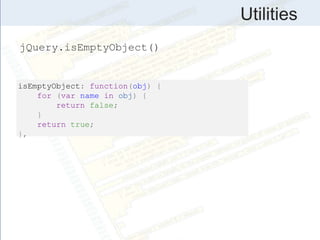

![Utilities
globalEval: function(data) {
if (data && rnotwhite.test(data)) {
// We use execScript on Internet Explorer
// We use an anonymous function so that context is
window
// rather than jQuery in Firefox
(window.execScript ||
function(data) {
window["eval"].call(window, data);
})(data);
}
},
jQuery.globalEval()](https://image.slidesharecdn.com/jquery-data-manipulate-v7-200109230852/85/jQuery-Data-Manipulate-API-A-source-code-dissecting-journey-18-320.jpg)
![Utilities
// Bind a function to a context, optionally partially applying any
// arguments.
proxy: function(fn, context) {
if (typeof context === "string") {
var tmp = fn[context];
context = fn;
fn = tmp;
}
// Quick check to determine if target is callable, in the spec
// this throws a TypeError, but we will just return undefined.
if (!jQuery.isFunction(fn)) {
return undefined;
}
// Simulated bind
var args = slice.call(arguments, 2),
proxy = function() {
return fn.apply(context,args.concat(slice.call(arguments)));
};
// Set the guid of unique handler to the same of original handler, so it
can be removed
proxy.guid = fn.guid = fn.guid || proxy.guid ||jQuery.guid++;
return proxy;
},
jQuery.proxy()](https://image.slidesharecdn.com/jquery-data-manipulate-v7-200109230852/85/jQuery-Data-Manipulate-API-A-source-code-dissecting-journey-19-320.jpg)
![UtilitiesjQuery.each()
// args is for internal usage only
each: function(object, callback, args) {
var name, i = 0,
length = object.length,
isObj = length === undefined || jQuery.isFunction(object);
if (args) {
if (isObj) {
for (name in object) {
if (callback.apply(object[name], args) === false) {
break;
}
}
} else {
for (; i < length;) {
if (callback.apply(object[i++], args) === false) {
break;
}
}
}](https://image.slidesharecdn.com/jquery-data-manipulate-v7-200109230852/85/jQuery-Data-Manipulate-API-A-source-code-dissecting-journey-20-320.jpg)
![UtilitiesjQuery.each()
// A special, fast, case for the most common use of each
} else {
if (isObj) {
for (name in object) {
if (callback.call(object[name], name, object[name])
===false) {
break;
}
}
} else {
for (; i < length;) {
if (callback.call(object[i], i, object[i++]) === fa
lse) {
break;
}
}
}
}
return object;
},](https://image.slidesharecdn.com/jquery-data-manipulate-v7-200109230852/85/jQuery-Data-Manipulate-API-A-source-code-dissecting-journey-21-320.jpg)




![Miscellaneous
toArray: function() {
return slice.call(this, 0);
}
Reversed - <span></span>
<div>One</div>
<div>Two</div>
<div>Three</div>
<script>
function disp(divs) {
var a = [];
for (var i = 0; i < divs.length; i++) {
a.push(divs[i].innerHTML);
}
$("span").text(a.join(" "));
}
disp($("div").toArray().reverse());
</script>
toArray()](https://image.slidesharecdn.com/jquery-data-manipulate-v7-200109230852/85/jQuery-Data-Manipulate-API-A-source-code-dissecting-journey-26-320.jpg)



![Miscellaneous// arg is for internal usage only
map: function(elems, callback, arg) {
var value, key, ret = [],
i = 0,
length = elems.length,
// jquery objects are treated as arrays
isArray = elems instanceof jQuery || length !== undefined &&typeof length === "number" &
& ((length > 0 && elems[0] && elems[length -1]) || length === 0 || jQuery.isArray(elems));
// Go through the array, translating each of the items to their
if (isArray) {
for (; i < length; i++) {
value = callback(elems[i], i, arg);
if (value != null) {
ret[ret.length] = value;
}
}
// Go through every key on the object,
} else {
for (key in elems) {
value = callback(elems[key], key, arg);
if (value != null) {
ret[ret.length] = value;
}
}
}
// Flatten any nested arrays
return ret.concat.apply([], ret);
},
.map(
)](https://image.slidesharecdn.com/jquery-data-manipulate-v7-200109230852/85/jQuery-Data-Manipulate-API-A-source-code-dissecting-journey-30-320.jpg)

![Miscellaneous
// Determine the position of an element within
// the matched set of elements
index: function(elem) {
if (!elem || typeof elem === "string") {
return jQuery.inArray(this[0],
// If it receives a string, the selector is used
// If it receives nothing, the siblings are used
elem ? jQuery(elem) : this.parent().children());
}
// Locate the position of the desired element
return jQuery.inArray(
// If it receives a jQuery object, the first element is
used
elem.jquery ? elem[0] : elem, this);
},
.index()](https://image.slidesharecdn.com/jquery-data-manipulate-v7-200109230852/85/jQuery-Data-Manipulate-API-A-source-code-dissecting-journey-32-320.jpg)
![Miscellaneous
// Get the Nth element in the matched element set OR
// Get the whole matched element set as a clean array
get: function(num) {
return num == null ?
// Return a 'clean' array
this.toArray() :
// Return just the object
(num < 0 ? this[this.length + num] : this[num]);
},
.get()](https://image.slidesharecdn.com/jquery-data-manipulate-v7-200109230852/85/jQuery-Data-Manipulate-API-A-source-code-dissecting-journey-33-320.jpg)

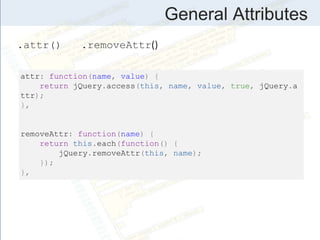
![General Attributes
prop: function(name, value) {
return jQuery.access(this, name, value, true, jQuery.
prop);
},
removeProp: function(name) {
return this.each(function() {
// try/catch handles cases where IE balks (such
as removing a property on window)
try {
this[name] = undefined;
delete this[name];
} catch (e) {}
});
},
.prop() .removeProp()](https://image.slidesharecdn.com/jquery-data-manipulate-v7-200109230852/85/jQuery-Data-Manipulate-API-A-source-code-dissecting-journey-36-320.jpg)